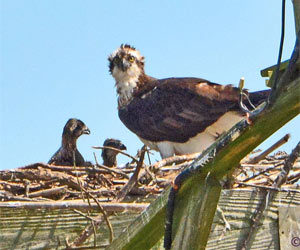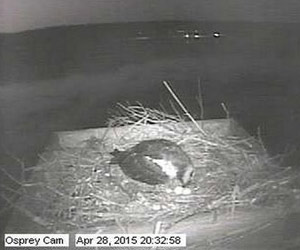Osprey Cam Questions and Answers
For those who want to know more about the nesting behavior of Chesapeake Bay ospreys (incubation, hatching, etc.) be sure to check out our Osprey Facts page. And for teachers, be sure to see the Project Osprey Curriculum guide (PDF, 858 KB).
The following are the most frequently emailed questions regarding the Osprey Cam at Blackwater National Wildlife Refuge (NWR). We hope this information helps you learn more about the cam:
Why does the camera view look different than previous years?
Answer: In 2018, we migrated our operation from a single-image update to a live streaming video/audio presentation.
Why does the platform look so empty when the ospreys return from migration in March?
Answer: Over the winter, the ospreys weren't at the Refuge to maintain the nest, so many of their original sticks have blown out or been removed by other birds (eagles, vultures, etc.). It never takes the ospreys long to fill it again—this also ensures that the material is fresh at the start.
Why do the ospreys like the platform?
Answer: The ospreys like the platform for several reasons. One important factor is that it's higher than anything around it. Ospreys often prefer to be in the highest structure in the general area, and this platform gives them an unobstructed view around their home. And although the platform is on land (many osprey platforms are in the water), this nest is very high off the ground, so they're safe from land predators like raccoons. Finally, in front of the platform (the side you cannot see on the cam) is the Blackwater River, which is where the osprey family will do a lot of its fishing—so food is just outside the front door.
Is this the same osprey couple as last year?
Answer: We're not sure if it's the same couple, since we don't band ospreys at the Refuge. We normally look at the female's necklace—the brown coloring on her chest—to see if the female looks similar to the female from the previous season. Ospreys do mate for life and are very loyal to their nest sites, so an osprey pair will usually return to their previous nest, assuming both survived migration.
Where do the ospreys spend the winter?
Answer: The ospreys migrate south in late August and early September because fish are hard to find at Blackwater NWR during the winter, and ospreys are dedicated fish eaters. The family migrates separately with the mother leaving first, followed by the father, than the siblings. They all go to different places in the south, but we suspect most of them end up in South America based on research performed on migrating ospreys from the Mid-Atlantic states. Once the ospreys are back, they will spend all spring and summer at Blackwater NWR, then migrate again around late August or early September.
Unlike the ospreys, the eagles at Blackwater NWR stay throughout the winter because they are not reliant on live fish and can eat waterfowl, small animals, and carrion instead.
Where do the ospreys go at night?
Answer: The female osprey will stay at the platform when there are eggs or chicks in the nest, but both parents often sleep away from the platform when it's empty. The ospreys seem to prefer to sleep or roost in nearby trees, much like the eagles. When the female osprey is close to laying the first egg, she sometimes spends the night in the nest.
Is there a light shining on the ospreys at night?
Answer: The Osprey Cam uses infrared technology (like the military uses) to provide "night vision," so there is no light shining on the ospreys in the evening—it just looks that way.
Will the fledglings from previous years return this spring?
Answer: Osprey fledglings do not return from the south until they are 2-3 years old. Once they have matured, they will return north, most likely to the area where they were born.
Return to the Blackwater NWR Osprey Cam or the Cam Central page.


